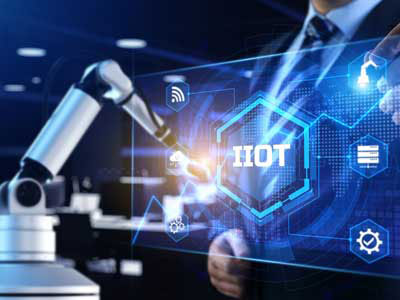Key Takeaway
The future scope of Industrial Internet of Things (IIoT) is vast and transformative. In manufacturing, IIoT will boost production efficiency and cut costs. It will also enable predictive maintenance, helping to avoid equipment failures before they happen. Beyond manufacturing, IIoT will impact energy management by optimizing consumption and reducing waste. In logistics, connected supply chains will improve transparency and coordination. Additionally, industrial automation will become more advanced with IIoT, leading to smarter, more adaptable robots. Overall, IIoT will drive innovation, making industries more efficient and competitive.
Current Trends and Adoption Rates
The Industrial Internet of Things (IIoT) is revolutionizing the manufacturing and industrial sectors. IIoT involves connecting industrial equipment and machinery to the internet, allowing for real-time data collection, analysis, and decision-making. Current trends show a rapid adoption of IIoT technologies, driven by the need for increased efficiency, reduced downtime, and predictive maintenance. Companies are leveraging IIoT to optimize operations, improve safety, and enhance productivity. Adoption rates are soaring as industries recognize the value of data-driven insights and the competitive advantage IIoT provides. With the integration of advanced sensors, cloud computing, and AI, the IIoT landscape is continuously evolving, setting the stage for future advancements.

Emerging Technologies and Innovations
Emerging technologies are pushing the boundaries of the Industrial Internet of Things (IIoT), introducing innovative solutions that enhance its capabilities. Advanced analytics, edge computing, and machine learning are transforming how data is processed and utilized. Edge computing, in particular, enables real-time data processing at the source, reducing latency and improving decision-making speed. This means that instead of sending all data to a central server, devices can process information locally, leading to faster responses and more efficient operations.
Innovations in AI and machine learning are enhancing predictive maintenance, allowing for the early detection of potential issues and reducing downtime. Machine learning algorithms analyze historical data to predict when equipment might fail, enabling preemptive repairs. Additionally, advancements in 5G technology are expected to revolutionize IIoT by providing faster and more reliable connectivity. This will allow for more devices to be connected simultaneously, facilitating seamless communication and data transfer. These technological innovations are not only improving efficiency but also opening new possibilities for automation and smart manufacturing, driving the industry towards a more interconnected and intelligent future.
Market Growth and Projections
The IIoT market is experiencing significant growth, with projections indicating a robust future. Market research forecasts suggest that the global IIoT market will reach unprecedented heights in the coming years. Factors driving this growth include increasing demand for automation, advancements in sensor technology, and the rising need for energy-efficient solutions. Industries such as manufacturing, transportation, and energy are at the forefront of IIoT adoption, leveraging these technologies to enhance operational efficiency and reduce costs.
The market is also witnessing increased investment in research and development, further accelerating growth. Companies are investing heavily in innovative solutions to stay competitive and meet the evolving needs of their customers. With expanding applications and the continuous evolution of technologies, the IIoT market is poised for exponential growth, transforming various industrial sectors. As more industries recognize the benefits of IIoT, such as improved productivity and reduced downtime, the adoption rate is expected to surge, solidifying IIoT’s role as a cornerstone of modern industrial operations.
Challenges and Opportunities
Security Concerns
The integration of Industrial Internet of Things (IIoT) brings significant advantages, but it also introduces notable security challenges. With numerous connected devices, the risk of cyberattacks increases, posing threats to sensitive data and industrial operations. Ensuring robust security protocols is paramount. Implementing end-to-end encryption, secure authentication methods, and regular security updates are essential measures. Industries must invest in cybersecurity training for employees to recognize and mitigate potential threats. By prioritizing security, the reliability and trustworthiness of IIoT systems can be significantly enhanced.
Interoperability
Interoperability between different IIoT systems and standards is a critical challenge that industries must address. Diverse devices and platforms need to communicate seamlessly to fully leverage IIoT’s potential. Developing standardized frameworks and protocols is crucial. This not only enhances compatibility but also simplifies integration and maintenance processes. Interoperability fosters innovation by enabling the combination of different technologies and systems, leading to more efficient and effective industrial operations. Addressing this challenge opens up new avenues for collaboration and growth within the industrial sector.
Long-Term Industry Impact
Redefining Industrial Processes
The long-term impact of IIoT on the industry is transformative. Traditional industrial processes will be redefined, becoming more efficient, flexible, and intelligent. IIoT enables real-time monitoring and control, allowing for immediate adjustments and optimizations. This leads to improved productivity and reduced operational costs. The integration of IIoT with artificial intelligence and big data analytics further enhances these benefits. Predictive and prescriptive maintenance can be implemented, reducing downtime and extending the lifespan of equipment. The result is a more resilient and responsive industrial environment.
Smart Factories
IIoT paves the way for the development of smart factories, where machines and systems communicate seamlessly. This connectivity allows for optimized production processes and resource utilization. Smart factories can adapt to changes in demand and production conditions dynamically. The increased data sharing within IIoT systems drives innovation, leading to the creation of new business models and revenue streams. In the long run, IIoT will be a cornerstone of Industry 4.0, revolutionizing the industrial landscape and setting new standards for efficiency and productivity.
Conclusion
The future scope of IIoT is expansive and transformative. As current trends and emerging technologies continue to shape the landscape, IIoT will play a pivotal role in driving industrial innovation and efficiency. Market growth projections indicate a bright future, with significant opportunities for industries to capitalize on IIoT advancements. While challenges exist, they also present avenues for developing robust, secure, and standardized solutions. The long-term impact of IIoT will be profound, leading to smarter, more efficient, and sustainable industrial practices. Embracing IIoT will not only enhance productivity but also foster a culture of continuous improvement and innovation in the industrial sector.
